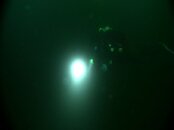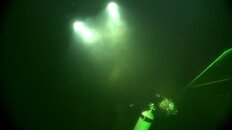Curious about the layer...could it have been a hydrogen sulfide layer? I recently recovered a major artifact in a freshwater lake and at around 100 + feet ran into a hydrogen sulfide layer. The artifact was embedded (partially) in the mud and it seems much like your rudder/tiller was black. At some points lights were pretty useless and it became all a matter of feel.
BTW - nice report.
Thanks!
I've just done an internet search on hydrogen sulfide layers in water. That may have been what it was.
I was reviewing my log of other dives at this lake and found other encounters with a smoky kind of decreased visibility, all in 2005, one beginning at 85', just after ice-out, and another beginning at 65', in early November. The encounter at 102' was in August of that same year. Water temps were 39F, 48F and 42F respectively, FWIW. We did not encounter it on this recent 89' dive this year (9/19/2009).
The shallower ones may have been stratified, but it was hard to tell, since they appeared more as the side of a cloud. I didn't really get a sense of stratification, since I didn't bother to swim above it. The bottom there was almost flat, unlike the 110' crease which really created a pocket that is probably more likely to trap and concentrate such a layer.
I have a feeling the 110' crease in Dublin Lake doesn't get much "turnover". On sonar, that crease appeared well defined with the depths from 100 to 110' taking an elliptical shape about 150' long by 50' wide. The crease was flanked on three sides by fairly steep slopes reaching up to about 50 to 60'. The fourth side (to the east) is a more gradual slope only coming up to the 80' trough that pretty much runs down the middle of the lake.
Found some interesting pics and links, including some fascinating cave video exerpts:
T-Nation.com | Underwater Lake - Page 1

This in Cenote Angelita cavern in Mexico. It is fresh water down to about 30 meters. At 30 meters there is a "lake" of hydrogen sulfide that sits atop 30 meters of salt water. Makes for a very interesting visual. Especially with the little "island" and tree branches. Came across this and thought it was pretty cool.
Another interesting site about seasonal lake stratification:
seasonal lake statification
This makes things more interesting, as now I can set a dive goal of finding the layer and taking a water sample from it! I'll make sure I have a dive buddy for that dive, so I can have him sniff the sample after the dive to see if it's got hydrogen sulfide in it.

I'll have to start carrying a water sampling container at Dublin Lake! I love having a mission on a dive!
Dave C
Last edited:






